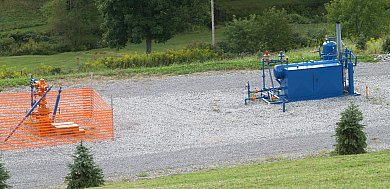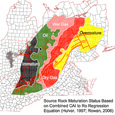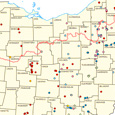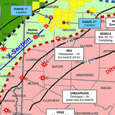Marcellus Shale Drilling: Can safe water supply be sustained?
Friday, September 24, 2010

(Part II in three-part series.)
SALEM, Ohio — Oil and water, they don’t mix right? What about oil, water and natural gas? It doesn’t appear they mix either, if the proper precautions are taken by both the landowner and driller.
Concerns over keeping drinking water safe over the Marcellus Shale drilling process is on everyone’s minds.
For example, 13 families filed a lawsuit filed Sept. 13 in Susquehanna County near Allentown, Pa., saying a faulty well drilled by Southwestern Energy Co. of Houston, Texas, leaked fracking fluid into the surrounding groundwater. The suit claims the cement casing in the well was defective.
At one time or another, these concerns and others cross the minds of landowners and residents in a drilling area.
At Penn State University, water resources specialist Brian Swistock has been studying Marcellus Shale drilling and the effects, if any, on water wells.
According to Swistock and others at Penn State, the contamination of private wells and springs can occur, but it has not been common for the past few decades.
Water source concerns also rise around the possibility of something going wrong in the drilling process. Risks include leaking storage pits, the illegal disposal of fracking fluid, site spills, infrequent inspections and the possibility of methane migration to groundwater.
State regs
There are some existing regulations in Pennsylvania to protect the drinking water supply.
The state requires a 200-foot setback from the gas well to water supplies. Drillers are also required to use a pit and tank for the collection of waste fluids.
The state also requires certified mail notification if the water supply is within 1,000 feet of a gas well.
Swistock said there is legislation being considered in Pennsylvania to increase the notification requirement from 1,000 feet to 2,500 feet, but it hasn’t been signed into law yet.
Hydrofracking
Water concerns often are raised around the hydrofracking process, which is when the drilling water company uses high-pressure fluids to break the gas-producing rock to improve the flow of gas.
Along with large amounts of water, various other materials may be used or mixed with the water for the fracturing process, including sand, oils, gels, acids, alcohol and various manmade organic chemicals.
When the fracking process is completed, the fluid comes back out of the well. It often includes a very high salt content, a high level of total dissolved solids, oil and grease and the additives.
Some residents are concerned this material can contaminate their drinking water supply. However, the cement casing used for the drilling process often prevents contamination, according to Penn State University.
Swistock said some water problems already exist prior to the drilling and often show up in pre-drilling testing.
The problems are usually aesthetic, such as hard water, high iron and a low pH level.
Health effects often have no symptoms, but can include a high level of lead, nitrates and even e-coli.
Swistock recommends property owners focus their pre-drilling water testing on issues related to the drilling and always use a state certified lab for results.
Predrill survey
Everyone who resides or has property where the drilling occurs, or will be located in an area near it, should cooperate with a water survey.
Swistock said drilling companies will often arrange for the survey and if they don’t include it in a lease, it should be required.
The property owner must do his part by cooperating and allowing access for the pre-drilling sample collection.
Who’s testing?
He also recommended that you ask for identification and confirm the testing will be done by an unbiased laboratory (third party, and check to see if it is not owned by the drilling or energy company.)
Swistock said the use of a third party to test the water sample is critical if problems arise after the drilling.
The test will look for the total dissolved solids in the water, barium, pH, chloride and methane gas levels.
Postdrill survey
A water survey is rarely done by a drilling company after it has drilled unless it is stipulated in a lease and, caution experts, they probably will not check for the quantity of water.
However, Swistock said a reduction in a well or spring yield is unlikely. He does recommend getting documentation of the pre-existing well or spring yield.
Swistock also recommends being on the lookout for sediment problems in surface water. He added the highest risk for this happening is when the drilling begins. It will be easy to spot because it will include a change in the water appearance, which could include effervescence, a spurting faucet or a foamy appearance.
Seismic testing
There are no regulations in Pennsylvania or Ohio regarding seismic testing for Marcellus Shale drilling.
However, landowners should stipulate a setback away from their water supply in their leases.
Property owners should arrange for a well or spring yield test before allowing seismic testing near the water supply.
According to Penn State University, the gas well operator is presumed to be responsible for pollution of any drinking water supply within 1,000 feet of the gas well if it occurs within six months after completion of the gas well.
The operator can use any one of five defenses to prove they are not responsible for water contamination including:
• The pollution existed prior to the drilling.
• The landowner refused to allow the operator access to conduct a pre-drilling water test.
• The water supply is not within 1,000 feet of the well.
• The pollution occurs more than six months after completion of drilling.
• The pollution occurred as the result of some cause other than the gas drilling.
Methane gas
One surprising thing to note from Swistock is that something such as methane gas in a water supply can be treated.
Swistock said he considers the treatment “pretty easy.”
He said there are at least two possibilities, including a ventilator wellcap or an aerator system.
Swistock said as the number of new Marcellus Shale gas wells are drilled, keeping surface water safe will become increasingly important across Pennsylvania, West Virginia and Ohio.
(Next week, our final installment.)




